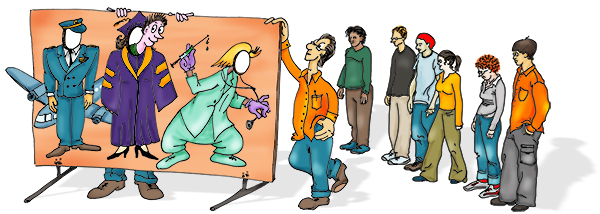 By our very nature, humans are an “us versus them” kind of mammal. We are quick to judge and categorize: “he’s our kind’a people” or “she’s management.” We adapt and root for our favorite sports teams, sometimes even resorting to violence to “defend our guys.” We peg an art department against the engineers; we side with nurses over doctors; we fight with democrats against republicans; we wave our flags in a spirit of nationalism. And it doesn’t matter if we all work for the same company, heal the same patients, want the same basic rights, or live on a very small planet—we tend to take sides. So it’s no surprise that when product designers develop products the feeling of “us against the users” creeps up into the process.
By our very nature, humans are an “us versus them” kind of mammal. We are quick to judge and categorize: “he’s our kind’a people” or “she’s management.” We adapt and root for our favorite sports teams, sometimes even resorting to violence to “defend our guys.” We peg an art department against the engineers; we side with nurses over doctors; we fight with democrats against republicans; we wave our flags in a spirit of nationalism. And it doesn’t matter if we all work for the same company, heal the same patients, want the same basic rights, or live on a very small planet—we tend to take sides. So it’s no surprise that when product designers develop products the feeling of “us against the users” creeps up into the process.
To protect the design process from these “us versus them” impulses, we can create a well-realized user personas based on the the audience taxonomy developed during the conceptual design stage of product design. For each major category in the audience taxonomy, a sample fictional user is created which embodies all of the traits in that audience category: age, profession, socio-economic background, culture and sub-culture, interests and dislikes, family status, education level, etc. But in addition to the standard description that defines a particular audience category, the sample user persona also needs to have a name and history—something that we as designers can relate to personally. So instead of talking about neurosurgeons, we start to discuss Dr. Evens: he has two small children and so needs to get home at a reasonable hour; he spends many hours per day standing in an operating room and needs good footwear; he’s left-handed and needs the interaction designed accordingly; he has a thriving practice and has to follow-up with 20 patients per day; and so on. Whatever product we design has to work for this guy, for Dr. Evens. By taking the general out of the conversation, we can feel sympathy for this one guy, one user, and as a result, we move away from blaming the users for the errors they make with our products.
Each category of users in the audience taxonomy should get a few of “Dr. Evens” as representatives of the audience’s needs, desires, strengths, and fallibility. And during the design meetings, we should be talking how we can help Dr. Evens do his job better, faster, and in a more economical way. Our products would be better for it!

1 comment for “Be the Customer”